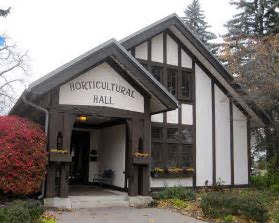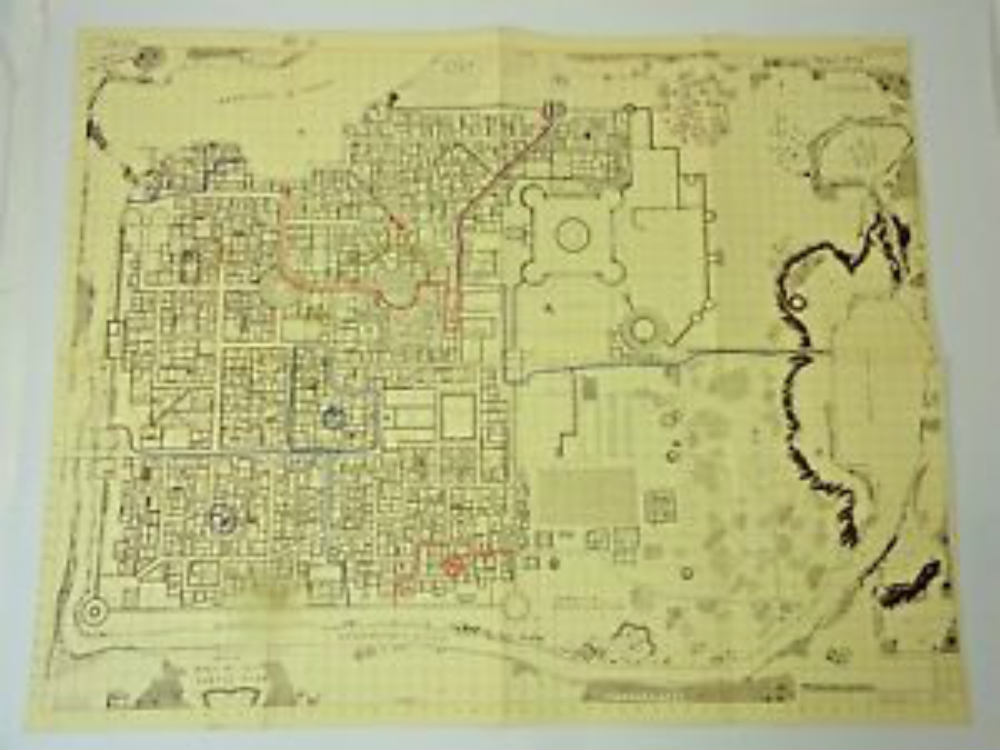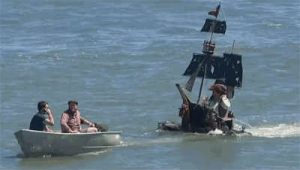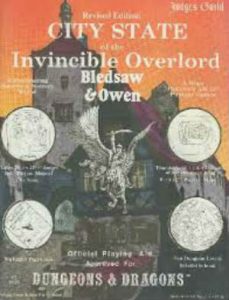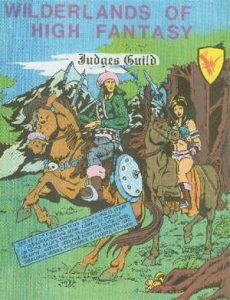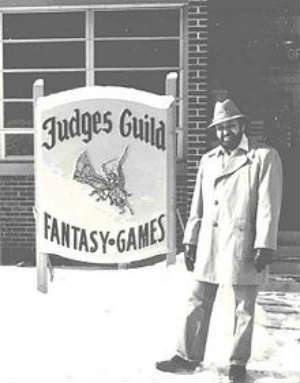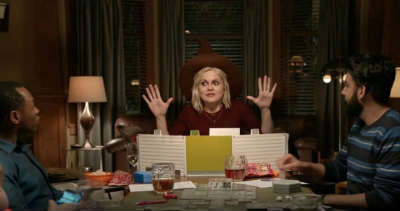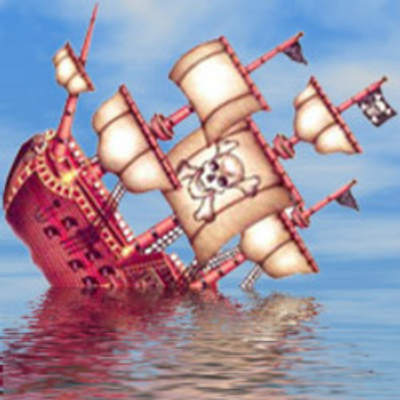Part 2
Prequeling this great old module:
The location of The Lichway is a tidal basin about (in my game world) 80 miles north of the Kingdom of Tanmoor, of which this area is officially a part of. The "Sandlands" is a wild area, for a thousand years inhabited by (as the module describes) a "dour coastal people," The Sandlanders, who as the module seems to not so subtly suggest worship undead and include undead raising rituals in their funerary rights. That was long ago actually, before colonists from the Acherian Empire to the east founded the city of Tanmoor, and interbred with the coastal first people of the area. Early on the Sandlanders were diminished, their small kingdom absorbed and their magnificent necropolis known as The Lichway abandoned and forgotten about. The people of the Sandlands fell into a certain primitism and the once great community reduced to several small fishing villages along the wild coasts of the north, mostly beneath the notice of the Kingdom that doomed their culture.
But the Lichway sits, patiently. The "Susurrus" awaiting release, while the interned are awaiting as well.
So as I mentioned in my last post, the module just starts you in the Korm basin, and you can float in to the covered cavern up to the old docks, or you can come in through the tunnel that leads outside. Within the complex are several more or less unrelated factions just hanging out in this desolate area, because reasons. And by that I mean no reasons. The main group is the human female Magic user Dark Odo and her group, that consists of several evil personages of various races and classes. Fighters, a cleric, a thief, etc. They have taken up residence in the part of the complex the players are unlikely to pass through first (out of the maybe 4 or 5 times I ran it they never entered that side of the place first, it requiring swimming through dubious water or secret doors). Odo's party has a couple of captives (one of them bound and clearly a sex slave for Odo's fighters), probably previous adventurers. they more or less count as yet another faction.
There are a pair of Man-Beasts (from White Dwarf magazine just like this module) hanging out near the main halls, and near the entrance the party is likely to encounter a quartet of thieves that are rummaging about in one of the first trash strewn rooms and trying to bust down a door a magic user is hiding behind. These folk don't seem to be related in any way to Odo's group (the magic user has actually been ousted by Odo), even though the complex is not exactly vast. Why this place that has sat undisturbed for hundreds of years is suddenly having a convergence of intruders is not explained, in true old school (lazy) style.
Well, I decided on my last go with Lichway about a year ago for a new group to change things up and come up with a fairly involved backstory for all this.
But before I go any further I should say that the fact that I used this module several times in the same gameworld should itself raise some questions. My land of Acheron has been my D&D jam since I was a kid. I have maintained a certain history (more often than not created by player characters over the decades) and consistency with it, but the Lichway is clearly an exception. I have only used it with completely new groups each time, so it was fairly easy to retcon each time. I mean, unleashing hundreds of howling undead that cannot leave the complex doesn't exactly change your game setting in any way. It just IS. A secluded location nobody will go to unless you need want use to it again.
The time before last, maybe 5 years ago in my old group in Los Angeles, the only real change I made to this was to have Dark Odo be a Drow. A sort of free agent and drow empire renegade, she sought the treasure of the Lichway to fund her own power base on the surface world. There being an old abandoned drow outpost in the upper caves of the local underdark entrance, she also pondered the possibility of reestablishing her own drow powerbase in the local sub-surface areas.
There was at least a couple of other changes in NPC's I made. Runis, one of Odo's fighters, was now a local and pureblood direct descendant of the original Sandlander culture. I had Dark Odo fill her head with notions of the Sandlanders reclaiming their heritage and the local lands from Tanmoor. If she followed Odo she would become a queen of a new kingdom. All they needed was the vast treasure hidden in the Lichway.
The rest of Odo's gang were made up of followers whom she also entranced with promises of money and power to come. The Man Beasts were an exception. Not true followers, the were paid by Odo as body guards, scouts, and extra security (In the original material the Man Beasts seemed to have no connection to Odo's gang despire close proximity).
The four thieves near the Lichway entrance were a gang from Tanmoor who heard about the necropolis from Odo, but most of this is getting ahead of myself.
Odo had visited the Korm basin area briefly to learn what she could of Lichway, and this is where she met and originally charmed Runis. Odo then went with Runis to Tanmoor in hopes of learning more secrets about The Lichway before taking it on. If you were to do something similar there are many ways to go about it, but I had Dark Odo come into contact with Merlo Von Tanmoor, one of the last of an old Tanmoorian family of wealth who also happened to be the youngest professor of history at the college.
Merlo was also a contact of the players in their first games, someone who could use them for important personal missions, i.e. helping obtain historical objects. Merlo, and associates of his from the Wizards Guild and other city groups actually regularly used adventuring groups/mercenaries with special skill sets to perform small quests. This was not only how Merlo met the PC's, but he also knew Dark Odo and friends. Odo had come to Tanmoor hoping to find out more details from historians about The Lichway before encountering its dangers, and in a meeting with Merlo and others she found that the info was lacking, knowing no more details than Odo's Sandlander follower Runis. But Odo found another use for Merlo; helping get others to the Lichway that she could either add to her growing gang, or victimize and rob once she planned to set up an HQ there. She counted on Merlo Von Tanmoor's curiosity for obscure historical things and Lichway was right up his alley.
Merlo threw a seasonal party for his vast amount of college and wizards guild associates, and some of the adventurer's often used by him and others were also invited. This included the party, and also Dark Odo and some of her party members such as Runis (Runis attending in traditional Sandlander garb; lots of shore bird feathers and shells as adornment. I really liked to play up her coastal wilderness roots). Though Odo fascinated Merlo, he (a magic user who did not tend to use his abilities openly) could see she was a manipulator and did his best to avoid her wiles. Merlo did insinuate to the characters the he had been intimate with her, so they could never be sure she wasn’t truly manipulating him at least subtly.
The player party got to know Odo a bit at the party, and player Leslie, running a female half orc fighter named Emen, had her character become attracted to the dour but ruggedly lovely Runis. This was an unexpected development that I knew I could exploit for the eventual encounter in The Lichway.
Also in attendance was the thief/mercenary party who called themselves "The Four Blades." These would eventually be the thieves encountered in The Lichway. To spice up the future encounter between the party and the thieves, I made it so the half elf member of The Four Blades had a hatred for orcs. A tense encounter and near fight with him and Emen heated things up, and set up some tension for their later meeting again at the Lichway.
Runis and a couple other of Dark Odo's band (including the female Man Beast) had a city adventure with the party that night. Runis and Emen, having at attraction to each other spent a couple of days in each others company after that, Runis confiding to Emin about Odo's promises of making her a ruler of a new kingdom in the Sandlands. This relationship, pursued originally by Emin, was a great way to create future drama for the Lichway encounters. I could never have predicted it, but it was only made possible by bringing the PC's and NPC's together socially.
Dark Odo gathered up Runis and the rest of her band and left for the Sandlands, hoping to beat any that she told about The Lichway there to prepare for either recruiting or robbing them.
A couple of weeks went by in the city before Merlo summoned the party. He told them that besides Dark Odo and her gang heading off to Lichway, some other adventuring groups, such as The Four Blades, had also eventually embarked south for The old Sandlands. Knowing Odo spread news of the place, he could only wonder about her motivations. Curios about that, and the historical value of the situation, he tapped the party to go find The Lichway, discover what Odo was up to, and bring him back any information about the place they could learn.
That was all the set up, and as I said the Runis/Emen would have potential for drama. After the party had some encounters around the village close to Lichway, they entered and went about exploring in the manner it usually is done (finding the key to the Susurrus cage early on) outside of encountering folks they knew. The Four Blades, inspired to check out Lichway a couple weeks earlier by Odo in Tanmoor, were exploring one of the initial areas and trying to flush out the mage as indicated in the module. There was a near fight, but the thieves were convinced by the stronger party to leave the place and so they did.
The ultimate encounter with Odo and here gang went violent fairly quickly, but as Runis was emotionally divided by Odo and Emen she was a basket case and refused to fight. The long and short of it had most of Odo's group decimated, Odo herself escaping, and Runis falling in with the player party and more or less becoming a follower for Emen. Oh, the short of it is seeing as they had a cage key things went as they often do here; the Sussurus escapes, the dead rise, and the party runs like hell.
One characters strongly suggested they lock themselves in the cage. You can imagine how that might work out. Starving to death huddles in a cage while howling skeletons reached in at you. But stronger heads prevailed and they just high tailed it with the undead riot chasing close behind.
So that's it. In a nutshell you can find any old way to get the player characters into encounters with Odo and the others at some point before the delve. You could have Odo's gang, and maybe the Four Thieves, frequent the same tavern and socialize with them there. Maybe they all hear about the Lichway at the same time. You'll need a way to delay the party a few days so Odo and the rest can get there ahead of them and be a bit settled in, though the Four Thieves seem to have arrived just ahead of the party as written in the module.
There are probably a ton of ways to get the NPC;s into a social encounter with the PC's. As I did just have them at a rich persons party with an NPC in common to introduce them.






